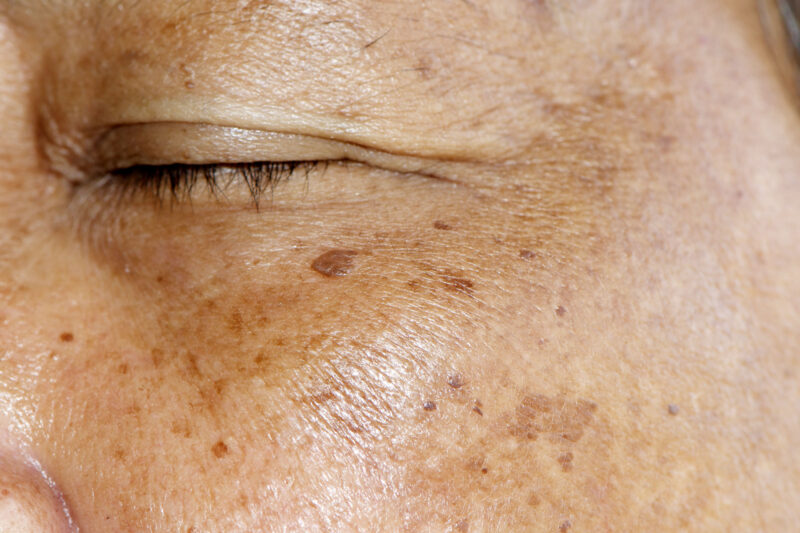Hi there! 1st time mom here. I have pregnancy mask on my check bone lines and am looking for something to reduce the dark appearance of them. Do you have any suggestions?
The dreaded pregnancy mask. It is something that many women don’t hear much about until you’re actually pregnant, at least I didn’t.
Pregnancy mask is also called Melasma, and the irregularly shaped areas of different pigmentation can be lighter or darker than the surrounding skin and tend to occur mostly on the cheek, upper lip, chin, forehead, neck and upper arms. Once Melasma starts, it is a chronic condition that can recur with hormonal fluctuations or sun exposure.
There are a lot of great products out there for treating Melasma. So many in fact that it can be completely overwhelming. Throw in a current pregnancy (or nursing post pregnancy) and it becomes even more confusing because a lot of those products are no longer safe to use.
Whether you’re pregnant, nursing, have never been pregnant or whatever, there’s a few basics behind treating melasma that ring true. And you can do easily adapt these guidelines for pregnancy safety. I follow these same guidelines when my own areas of Melasma flare up.
1. Sun Avoidance
It only makes sense that if you want to avoid hyperpigmentation, you would avoid one of the main triggers. Especially in the case of Melasma, where hormonal changes seem to exacerbate the sun’s effects on melanin production, minimizing your sun exposure and creation of more areas of hyperpigmentation.
True sun avoidance is best. If you can’t handle that, then avoid the sun as much as possible between the peak times of 10 am and 2 pm. I try to stay in the shade. We have lots of umbrellas in our backyard for a reason, or I’ll wear a big hat. You should also wear sunscreen daily, not just when you’re planning to be outside.
2. At Home Treatments
Yes, there are some easy to do at home treatments you can do that will at least help with melasma. It’s important to remember that while topicals will help, they might not be enough to really get rid of your hyperpigmentation. You may need to head to a dermatologist for more help. As well, since melasma is chronic, it’s keep to consistent! And it may take a long time to see results. Expect at least 12 weeks before you start seeing a difference.
Retinoids
Retinoids will not only help treat areas of hyperpigmentation by increasing cell turnover (and therefore revealing fresh cells in which less melanin has built up), but also acts as a tyrosinase inhibitor.
Tyrosinase Inhibitors
Tyrosinase is an enzyme needed for your skin to produce melanin. Stop the enzyme (aka- inhibit it), and you’ll stop or at least slow down melanin production.
There are a couple of tyrosinase inhibitors available over the counter in skincare treatments. Perhaps the best known is Hydroquinone, which you can get up to 2% without a prescription (prescription goes up to 10% depending upon the formulation). Arbutin, Kojic Acid and Licorice Root are also tyrosinase inhibitors.
Vitamin C
Vitamin C does work as a tyrosinase inhibitor, but it seems to be a little bit different than other tyrosinase inhibitors. Typically, you need to be careful with products like hydroquinone as they will reduce melanin production to all areas of the skin, but Vitamin C seems to only “work” on areas of hyperpigmentation. Unlike the other tyrosinase inhibitors, this one is felt to be safe for use in both pregnancy and nursing, in part because of the amount we ingest in foods like citrus fruit.
Read more:
• Vitamin C in Skin Care: How Does it Work?
• The Best Vitamin C Skincare Products
• Pregnancy Safe Vitamin C Skincare
Tranexamic Acid
There is some evidence that when other treatments don’t work, this one will help. It acts via the plasminogen/plasmin pathway, and currently is also felt to be safe for pregnancy/nursing.
3. Advanced Help from a Dermatologist
If you find that typical over the counter products just aren’t cutting it, it is time to seek the help of a professional! Depending on the location, extent of the hyperpigmentation and other characteristics of your skin a dermatologist may recommend a chemical peel, microneedling, platelet-rich plasma (PRP), or a laser/light treatment.
4. Makeup
Yes, you can always just cover things up with a bit of makeup. Rather than just reaching for the highest coverage concealer that you can find, I recommend using a peach/orange toned color corrector first over that hyperpigmentation. It will cancel out a bit of the brown, and you’ll need less concealer/foundation over the top.
Things to Remember:
It is easier to prevent areas of hyperpigmentation than to treat them! Sunscreen, peak sun avoidance… these can be annoying but necessary.
Consistency is key, since melasma is a chronic condition you’ll need to have a routine with products you’ll remember to use daily. Using 1 product each night and wearing sunscreen daily will go a lot further than the one week last month that you remembered to use 5 different products at night before bed. So, go for an easy routine that you can follow consistently.
You need to be patient. Expect a minimum of 12 weeks before you start to see results.
More info:
Pregnancy Safe Melasma Treatment


 I’m a doctor, a mommy and a bit of a beauty addict. If you let me, I can take 2 hours to get ready in the morning. Really. I'm on a quest for faster beauty that works!
I’m a doctor, a mommy and a bit of a beauty addict. If you let me, I can take 2 hours to get ready in the morning. Really. I'm on a quest for faster beauty that works!